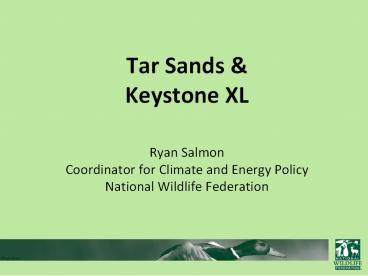Tar Sands PowerPoint PPT Presentation
Title: Tar Sands
1
Tar Sands Keystone XLRyan SalmonCoordinator
for Climate and Energy PolicyNational Wildlife
Federation
2
(No Transcript)
3
- Impacts of tar sands on wildlife, water and
communities in Canada. - Potential impacts along the pipeline right of way
and at the refinery. - Implications for Americas energy future and
climate change.
4
What are tar sands?
- Tar sands are a mixture of sand, silt, clay,
water and bitumen. - Bitumen is separated from the rest of the
substrate through an energy and water-intensive
process.
Suncor Energy Inc.
5
- Albertas tar sands are the second largest
petroleum reserve in the world 170 billion
barrels - They are concentrated in 3 deposits that underlie
an area of over 54,000 square miles
approximately the size of Florida. - Over 32,000 square miles or 60 of this area has
been leased for extraction through surface mining
or in situ techniques.
6
David Dodge
7
Surface Mining
- Used to access deposits less than 250 feet below
the surface. - To date, over 240 square miles of boreal forest
have been disturbed.
Peter Essick
8
Separation and Upgrading
- Producing tar sands emits 3 times the greenhouse
gases of conventional oil. - Requires large amounts of natural gas and water.
NWF
9
In Situ Extraction
- Used to access deposits more than 250 feet below
the surface. - Most future extraction will use in situ
techniques. - Higher greenhouse gas emissions than mining.
Suncor Energy Inc.
10
Tailings Ponds
- A toxic byproduct of tar sands extraction.
- Cover about 65 square miles about the area of
Washington, D.C. - Leak an estimated billion gallons per year into
the local environment.
NWF
11
Impacts on Wildlife and Communities
- Wildlife mortality
- Fish abnormalities
- High cancer rates in First Nation communities
12
(No Transcript)
13
CAPP
14
Impacts AlongKeystone XL
- Yellowstone and Missouri Rivers
- Prairie Potholes
- Ogallala Aquifer
- Platte River
- Neches River
15
BLM
16
Impacts at the Refinery
- Tar sands are higher in sulfur, nitrogen, and
trace metals than conventional oil. - More pollution in communities surround the
refineries that the pipeline would service.
AP
17
Implications for Americas Energy Future and
Climate Change
- Lock in a high-carbon fuel supply far into the
future and encourage expansion of the tar sands. - Undermine U.S. efforts to transition to a clean
energy economy. - Send the wrong signal to the global community
about U.S. leadership on climate change.
18
(No Transcript)
19
GHG Emissions
- On a well-to-tank basis, emissions from Canadian
tar sands crude would be about 82 greater than
conventional crude. - At 900,000 bpd, well to tank emissions from the
project would be 27 MMtCO2e. - Equivalent to emissions from 7 coal-fired power
plants.
EPA Comments on Keystone XL DEIS
20
The tar sands of Canada constitute one of our
planets greatest threats. James Hansen
21
There Are Better Alternatives
22
Thank YouRyan SalmonCoordinator for Climate
and Energy PolicyNational Wildlife
Federation202-657-3681salmonr_at_nwf.org

